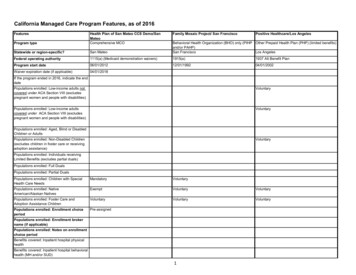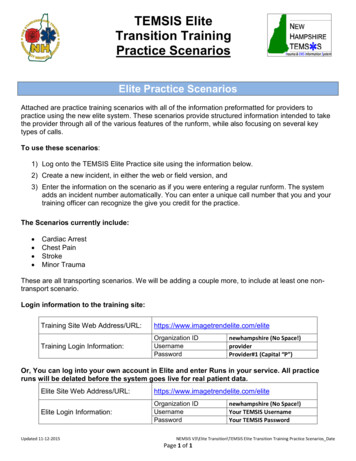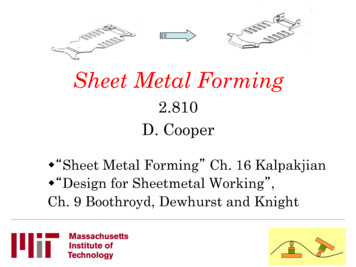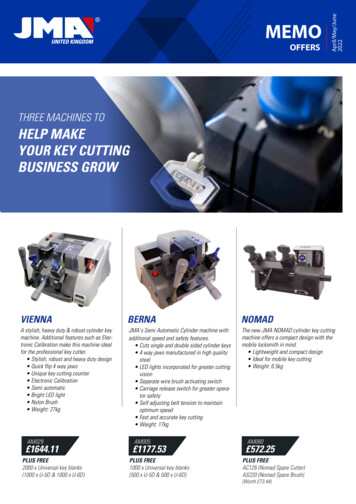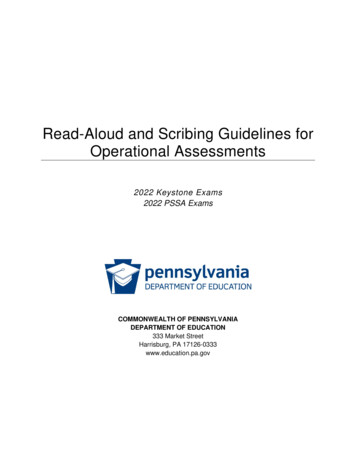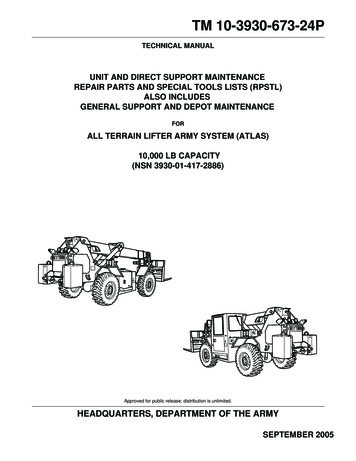
Transcription
TL-2000 Sting S4PILOT S OPERATING HANDBOOKThis Pilot s Operating Handbook must remain in the aircraft and be accessible to the pilot all times.
(THIS PAGE BLANK)
Dear Sting Owner:Congratulations on the purchase of your Sting S4! You will find your new TLUltralight aircraft very enjoyable, extremely economical, and easy to maintain.The Sting S4 is the ideal Light Sport Airplane. It is fast, economical, pleasing tothe eye, and user friendly. We at TL Aircraft are certain that your Sting will giveyou hours and hours of leisure flying and enjoyment. With this Pilot OperatingHandbook (POH), we hope to help inform you about the design and operationof your aircraft.This Pilot Operating Handbook is to be used as a guide to assist the pilot tosafely use the Sting S4 aircraft. The contents are not intended to be a finalauthority and although proofed extensively they are still not considered errorfree. Therefore, the pilot in command is the final authority for the safeoperation of the aircraft. Should there be any questions or errors found in yourreading this handbook please contact us immediately and we will issue aclarification. Please study and become familiar with this POH manual and therespective manuals for the propeller and rescue system.Thank you again for your business. We look forward to a continuing satisfiedcustomer relationship. Feel free to contact us if you have any questions orcomments regarding your Sting aircraft.Fly safe! Fly fun!(sig)Jiri Tlusty
Manufacturer:TL Ultralight, sroAirport, building no.84503 41 Hradec KraloveCzech Republicwww.tl-ultralight.comAirplane registration number:Date of issue: List of changesNr.DateRevised PagesType of RevisionPosted By06 June 2011NoneOriginal Issue-
TABLE OF CONTENTS1. GENERAL INFORMATION2. LIMITATIONS3. EMERGENCY PROCEDURES4. NORMAL PROCEDURES5. PERFORMANCE6. WEIGHT, BALANCE AND EQUIPMENT LIST7. DESCRIPTION OF AIRPLANE AND SYSTEMS8. HANDLING AND SERVICING9. SUPPLEMENTS
1. GENERAL INFORMATIONTABLE OF CONTENTS1.1 Introduction1.2 Aircraft1.2.1 Airplane gross weight1.2.2 Basic dimensions1.2.3 Three View Drawings1.2.4 Top speed, cruise speed1.2.5 Maximum range1.2.6 Rate of climb1.2.7 Stall speed1.3 Fuel capacity1.4 Engine power1-21-31-31-31-41-51-51-51-51-61-61-1
1.1 IntroductionThis manual is written and organized to conform to the ASTM F2245, Design andPerformance of a Light Sport Aircraft and ASTM F2746, Standard Specification forPilot s Operating Handbook (POH) for Light Sport AirplaneREAD BEFORE YOUR FIRST FLIGHT!CAUTIONA copy is issued with each aircraft and is required to remain in the aircraft andbe available to the pilot at all times.CAUTIONAll pilots of this aircraft must read and understand the operation andlimitations of this aircraft design.As such, many items are added as narrative information to assist them in clearlyunderstanding what is required and in most cases help in achieving the necessaryperformance. The POH does not intend to and cannot replace properly qualifiedground or in-flight instruction by an FAA certified flight instructor. (CFI)Maintenance and operation of major components, engine, aircraft parachute system,propeller, avionics or other installed equipment is provided in the appropriatemanufacturer manuals which are included with the aircraft. Any conflicts in thismanual should be superseded by the appropriate manufacturer’s manual.CAUTIONThe Sting is has a high cruising speed and may traverse very differentweather conditions during a single flight. The aircraft is designed andintended only for operation in VFR/VMC conditions. The pilot isresponsible for the safe flight of the aircraft and should be prepared toavoid any meteorological conditions which will endanger the occupants,the aircraft or both.1-2
1.2 AircraftThe TL-2000 Sting S4 is a full three axis, low wing, two place, side-by-side seating,tricycle landing gear aircraft with a steerable nose wheel. The primary aircraftstructure is carbon fiber and fiberglass UV resistant reinforced laminate with an innerfoam core creating a ‘sandwich’ layered construction between each ply.1.2.1 Airplane gross weightGross weight: 1320 lbs1.2.2 Basic dimensionsLength:Cabin width:Wing span:Height:20 ft. 4 in.44 in. 29 ft. 11 in.6 ft. 4 in.,AreasWing:Flap:Aspect ratio:Glide ratio:119,479 ft218.6 ft27.2612:11-3
1.2.3 Three View DrawingsAll dimensions arein millimeters1-4
1.2.4 Top speed, cruise speedVSPEEDVNOMaximum structuralcruising speedVHMaximum sustainedspeed in level flightIASCAS(mph)(mph)135,5 134,5140138REMARKSDo not exceed this speed except in smooth air,and even then only do so with caution.Maximum speed with maximum continuous ratedengine power in horizontal flight at sea level instandard conditions at full gross weight.Speeds shown are for full gross weight at sea level, standard conditions.1.2.5 Maximum rangeRange:455 NM (No Wind / No Reserve)Range (with wing tanks installed): 740 NM (No Wind / No Reserve)NOTEMaximum range cannot be obtained at high cruse powersettings. For detailed engine data see the Operation manualfor Rotax engine.1.2.6 Rate of climbRate of climb:810 ft/min at 63 mph, VY, max power, half flapsMaximum cruise speed: 138 IAS (VH, max continuous power)1.2.7 Stall speedIASCAS(mph)(mph)Stall speed (no flaps)50,549,5Do not attempt to fly slower than this speed at fullgross weight when operating without flaps.Stall speed (full flaps)43,542,5Do not attempt to fly slower than this speed whenoperating with full (Landing) flaps.VSPEEDVSVS0REMARKSSpeeds shown are for full gross weight at sea level, standard conditions.1-5
1.3 Fuel capacityTotal fuselage capacity:Wing fuel tanks capacity:Total fuel capacity (if wing tanks installed):Total unusable:Approved fuel grade:Alternate fuel grade:20.5 Gals2 x 6 Gals32.5 Gals1.5 Gals91 Unleaded auto gas (yellow)100LL Avgas (blue) (for less than 30%of engine operation time)1.4 Engine powerHorsepower rating and engine speed: 100 BHP at 5800 RPM1-6
2. LIMITATIONSTABLE OF CONTENTS2.1 Speeds limitation2.1.1 Airspeed indicator speed range markings2.1.2 Stalling speeds2.1.3 Flap extended speed range2.1.4 Maneuvering speed2.1.5 Never exceed speed2.2 Service ceiling2.3 Load factors limits2.4 Maneuver limits2.5 Fuel2.6 Horsepower rating, engine speed2.7 Flight limitations2-22-22-22-32-32-32-32-32-42-42-42-42-1
2.1 Speeds limitationNOTESpeeds shown are for full gross weight at sea level, standard conditions.2.1.1 Airspeed indicator speed range ap Operating Range. Lower limit ismaximum weight VS0 in landing configuration.Upper limit is maximum speed permissible withflaps extended to stage one (Takeoff) (Approach)setting.Normal Operating Range. Lower limit ismaximum weight VS at most forward CG with flapsretracted. Upper limit is maximum structuralcruising speed. VCMNWhite arc43,5 – 74,542,5 – 73,5Green arc50,5 - 135,549,5 - 134,5Yellow arc135,5 - 182134,5 - 180Caution Range. Operations must be conductedwith caution and only in smooth airRed line182180Never Exceed Speed. Maximum speed for alloperations.2.1.2 Stalling speedsStalling speeds at maximum take-off weight.IASCAS(mph)(mph)Stall speed (no flaps)50,549,5Do not attempt to fly slower than this speed at fullgross weight when operating without flaps.Stall speed (full flaps)43,542,5Do not attempt to fly slower than this speed whenoperating with full (Landing) flaps.VSPEEDVSVS0REMARKS2.1.3 Flap extended speed rangeIASCAS(mph)(mph)VFEMaximum flap extendedspeed:Half (takeoff) flaps:Full (landing) flaps:8674,58573,5Do not exceed these speeds with the given flapsettings. Damage to the flap mechanism mayoccur due to excessive air loads.VS0Stall speed (full flaps)43,542,5Do not attempt to fly slower than this speed whenoperating with full (Landing) flaps.VSPEEDREMARKS2-2
2.1.4 Maneuvering speedVSPEEDVAManeuvering speedIASCAS(mph)(mph)135,5 134,5REMARKSDo not make full or abrupt control movementsabove this speed.2.1.5 Never exceed speedVSPEEDVNENever exceed speedIASCAS(mph)(mph)182180REMARKSDo not exceed this speed in any operation.2.2 Service ceilingStandard conditions, standard day: 16,000 ft.LSA altitude limits:10,000 ft. or 2,000 above terrain2.3 Load factors limitsFlight load factors: flaps up: 4g, - 2gflaps down 2g, - 2g2.4 Maneuver limitsThis airplane is certified as a Light Sport Aircraft and is not approved for aerobatic flight,including spins. All aerobatic maneuvers, including spins, are prohibited. An aerobaticmaneuver, as defined by 14 CFR 91.303, is an intentional maneuver involving an abruptchange in an aircraft’s attitude, an abnormal attitude, or abnormal acceleration, notnecessary for normal flight.WARNINGWARNINGRNINGAll aerobatic maneuvers,including spins, are prohibited.2-3
2.5 FuelTotal capacity:Total unusable:Fuel consumption:Approved fuel grade:Alternate fuel grade:20.5 Gals1.5 Galsmax. 7.13 US gal/h (27l/h)91 Unleaded auto gas (yellow)100LL Avgas (Blue)NOTE100LL Avgas is to be used as an alternate fuel type if 91 octaneauto fuel is not available. Use of 100LL Avgas is restricted toless than 30% of engine operation time by the enginemanufacturer. If 91 Octane Unleaded is not available duringtravel, adding 100LL Avgas in any proportion to partial tanks of91 Unleaded is acceptable.2.6 Horsepower rating, engine speedHorsepower rating and engine speed: 100 BHP at 5800 RPM2.7 Flight limitationsThe Sting S4 is certified for VFR/VMC flight conditions. Operation under IMCconditions is considered an emergency unless the aircraft is so approved.NOTEIFR Flight operations do not designate IMC flight conditions.IFR operations limited to VMC conditions must be in accordance with theappropriate Manufacturer, FAA and ASTM standards.Approval for IMC operation by the manufacturer is aircraft specific. Each aircraft soapproved will have specific IFR IMC restrictions in the POH appendix and a referenceto these limitations will be displayed on the aircraft instrument panel.2-4
3. EMERGENCY PROCEDURESTABLE OF CONTENTS3.1 Emergency speeds3.2 Emergency checklists3.2.1 Engine fire during start3.2.2 Engine failure take-off roll (abort)3.2.3 Engine failure (landing) immediately after take-off3.2.4 Engine failure during flight3.2.5 Emergency landing without engine power3.2.6 Precautionary landing with engine power (off airport)3.2.7 Engine fire in flight3.2.8 Inadvertent spiral3.2.9 Inadvertent spin3.2.10 Low oil pressure or loss of oil pressure3.2.11 Carburetor icing3.2.12 Exceeding maximum airspeed3.3 Aircraft parachute system3.3.1 3-73-83-83-1
3.1 Emergency speedsNever Exceed Speed:182 IASStall Speed (No Flaps): 50,5 IASStall Speed (Full Flaps): 43,5 IAS3.2 Emergency checklists3.2.1 Engine fire during start:1. Starter.CONTINUE CRANKINGIf engine starts:2. Power.2000 RPM for a few seconds3. Fuel valve.OFF4. Engine.SHUTDOWN and INSPECT FOR DAMAGEIf engine fails to start:5. Throttle.FULL OPEN6. Starter.CONTINUE CRANKING7. Ignition switches.OFF8. Fuel valve.OFF9. Main switch.OFF10. Fire Extinguisher.OBTAIN11. Airplane.EVACUATE12. Fire Extinguisher.USE AS REQUIRED13. Airplane.INSPECT FOR DAMAGE3.2.2 Engine failure take-off roll (abort)1. Throttle.IDLE2. Brakes.APPLY3. Wing Flaps.RETRACT3-2
3.2.3 Engine failure (landing) immediately after take-off1.2.3.4.Airspeed.80,5 IASWing flaps.HALFFuel valve.OFFMain switch.OFF3.2.4 Engine failure during flight1.2.3.4.5.Engine restart:Airspeed.80,5 IASFuel valve.ONAux. fuel pump.ONIgnition switches.ONStarter.ENGAGEIf restart fails, execute a forced landing.3.2.5 Emergency landing without engine power1. Airspeed.80,5 IAS2. Landing zone.DETERMINE and FLY TOWARDSEngine shutdown:3. Aux. fuel pump.OFF4. Fuel valve.OFF5. Radio. SET TO 121.5; TRANSMIT MAYDAY, MAYDAY,MAYDAY!” and AIRCRAFT ID with CURRENT POSITION6. Transponder.SET TO 77007. Landing zone.CIRCLE OVER (if necessary)Before landing:8. All switches.OFF9. Harnesses.TIGHTEN10. Flaps.FULL (landing is assured)11. Touchdown.PREFERABLY INTO WIND, NOSE HIGH12. Brakes.APPLY AS REQURED3-3
3.2.6 Precautionary landing with engine power (off airport)1.2.3.4.5.6.7.8.9.Airspeed.80,5 IASFlaps.HALFHarnesses.TIGHTENSelected field.EXECUTE LOW PASS (only if practical)Electrical Equipment.OFF (EXCEPT IGNITION andMAIN SWITCH!)Flaps.FULLAirspeed.63 IASTouchdown.PREFERABLY INTO WIND, NOSE HIGHCanopy. UNLATCHCAUTIONThe canopy may fully open and depart the airframe, if itis unlatched in flight. If the canopy is unlatched, it maybe necessary to physically hold it down to prevent itfrom separating from the airframe.10. Brake. . APPLY AS REQUIRED3.2.7 Engine fire in flightWARNINGDuring an in-flight fire do not deploy the aircraftparachute system at high altitude. If the decision ismade to use the parachute system and conditionspermit, attempt to fly (DIVE) the aircraft to a loweraltitude to minimize the time for the fire to spread withinthe cockpit.3-4
1.2.3.4.5.6.Fuel valve.OFFThrottle.FULL OPENAux. Fuel Pump.OFFIgnition Switches .OFFCabin heat.OFFAir vents.AS REQUIREDWARNINGMaintaining approach speed, a low speed side-slip maycause the aircraft to stall and may enter a spin.7. Radio.SET TO 121.5; TRANSMIT MAYDAY, MAYDAY,MAYDAY!” and AIRCRAFT ID with CURRENT POSITION8. All non-essential switches.OFF9. Airspeed.63 IAS10. Flaps.FULL11. Force landing.EXECUTE3.2.8 Inadvertent spiralIf a spiral dive is encountered at night or with an inadvertent cloud penetration(IMC/IFR conditions), proceed as follows:WARNINGWARNINGA spiral dive at night orRNINGin instrument meteorologicalconditions (IMC) is a serious, life threateningemergency. Consider the use of the GRS aircraftparachute system as the primary recovery technique.3-5
See Aircraft Parachute system deployment.If the aircraft parachute system is not deployed:1. Airspeed.CHECK, IF THE AIRSPEED IS INCREASING2. Throttle.IDLE3. Airspeed.CHECK, IF THE AIRSPEED IS DECREASING4. Throttle.FULL OPEN5. Level the wings using coordinated aileron and rudderuntil the wings of the attitude reference or turn coordinatorare level. Do not attempt to change the nose pitch attitudeuntil the bank indication is level.6. Apply elevator pressure using the attitude reference tomaintain wings level until 80,5 IAS is established on theairspeed indicator and the altimeter stops moving.CAUTIONWhen recovering from a nose-low attitude, do not overstress the airframe by pulling back too abruptly on theflight stick.7. Trim the aircraft to maintain 80,5 IAS8. Upon re-entering VFR/VMC conditions, resume normal cruiseoperation3.2.9 Inadvertent spinWARNINGIntentional spins in this airplane areprohibited.Should an inadvertent spin occur in this airplane, the followingrecovery procedure should be used:3-6
.APPLY FULL (in opposite direction of rotation)Elevator.FORWARD (to break stall)Rudder.NEUTRALIZEElevator.RECOVER SMOOTHLY FROMNOSE-LOW ATTITUDECAUTIONClose the throttle to prevent an unnecessary increase in airspeed.During a spin, one wing is in a stalled condition resulting inineffective aileron inputs to control the rotation. Neutralize theailerons, and apply full rudder in the opposite direction of rotation.Because an airfoil can stall at any airspeed and in any relation to thehorizon, push forward on the stick to break the stall.3.2.10 Low oil pressure or loss of oil pressureIf a loss of oil pressure is accompanied by a rise in oil temperature, there is goodreason to suspect an engine failure may occur. Reduce engine power and select asuitable field for a forced landing. Use only the minimum power required to reach thedesired landing zone.3.2.11 Carburetor icingAlthough the aircraft engine has a full time carburetor heating system, anunexplained drop in manifold pressure and eventual engine roughness may resultfrom the formation of carburetor ice. Use both the throttle and the choke to maintainengine RPM.3.2.12 Exceeding maximum airspeedIf the aircraft exceeds VNE 182 IAS, reduce power and speed immediately. Do notattempt abrupt control movement or unusual attitudes. Continue flight usingminimum safe speed and control pressures to land as soon as possible. After landinghave the aircraft airworthiness confirmed by a qualified mechanic to return it toservice.3-7
3.3 Aircraft parachute system3.3.1 IntroducingWARNINGWARNINGRNINGThe aircraft parachute systemshould be considered as theprimary method of choice of recovery when the aircraft hasdeparted controlled flight (out of control).The Sting S4 comes standard with an aircraft parachute system manufactured by theGalaxy High Technology (GRS) Corporation. It is imperative that the owner/pilot ofthis airplane read and understand the system operating manual provided by Galaxy .In most emergency scenarios, the use of the system is not necessary. Theparachute system will increase the chance of occupant survival.If the system is used, certain steps should at least be attemptedprior to activation:1. Airspeed.SLOW THE AIRCRAFT, IF POSSIBLE2. Ignition.OFF3. Harnesses.TIGHTEN4. Parachute activation handle.PULL FIRMLY (25 POUNDS)5. Radio. SET TO 121.5; TRANSMIT MAYDAY, MAYDAY,MAYDAY!” and AIRCRAFT ID with CURRENT POSITION6. Transponder.SET TO 77007. Impact position.PULL LIMBS CLOSE TOBODY and COVER FACEFirmly pull the parachute activation handle out 18 inches withabout 25 pounds of force. The system should completeinflation in 1.5 – 3.5 seconds.WARNINGMaximum speed for aircraft parachutedeployment at gross weight: 141 mph.3-8
4. NORMAL PROCEDURESTABLE OF CONTENTS4.1 Preflight check4.1.1 Cockpit4.1.2 Exterior checklist4.1.2.1 Nose area4.1.2.2 Right wing4.1.2.3 AFT fuselage4.1.2.4 Left wing4.2 Operating checklist4.2.1 Engine start4.2.2 Pre-taxi4.2.3 Taxi4.2.4 Engine run-up4.2.5 Before takeoff4.2.6 Takeoff4.2.7 Climb4.2.7.1 Best angle of climb speed4.2.7.2 Best rate of climb speed4.2.8 Cruise4.2.9 Before landing4.2.10 Landing4.2.11 Soft field4.2.11.1 Soft field take off4.2.11.2 Soft field landing4.2.12 Balked landing4.2.13 After landing4.2.14 Shutdown4.2.15 Securing the 4-74-84-84-84-84-94-94-94-94-94-104-104-1
4.1 Preflight checkNOTEAll exterior preflight inspection items, including the cockpitsection, can be conducted from outside the airplane.4.1.1 Cockpit1. All switches.OFF2. Fuel valve.OFF3. Main switch.OFF4. Fuel gauge.CHECK QUANTITY5. ELT control panel indicator.CHECK STATUS6. Main switch.OFF7. Flight controls.PROPER OPERATION8. Flaps.PROPER OPERATION, SET FULL9. Trim.CENTERED10. Required documentation.ON BOARD11. Baggage.SECURED12. Seats.SECURE13. Proceed to exterior checklist4.1.2 Exterior checklist4.1.2.1 Nose area1. Windshield.CLEAN2. Cowling.SECURE, screws tight3. Prop/Spinner.CHECK4. Air inlets.CLEAR5. Oil.CHECK QUANTITY6. Coolant.CHECK QUANTITY7. Nose strut assembly.CHECK8. Nose tire.CHECK INFLATION and WEAR9. Chock.REMOVE10. Firewall fuel gascolator.CHECK for debris11. Fuel and oil tank vents.CLEAR4-2
12. Traffic alert antennae.SECURE13. Transponder antennae.SECURE14. Fuselage fuel pump.DRAIN, check forwater and contaminates4.1.2.2 Right wing1. Main fuel tank.CHECK QUANTITY / CORRECT FUEL TYPE2. Main fuel cap.SECURE3. ELT.CHECK ARMED AND SECURE4. Gear leg and brake line.CHECK5. Wheel pant and bracket. . SECURE6. Brake pads and disk . . .CHECK FOR WEAR7. Tire . . CHECK INFLATION and WEAR8. Chock . . . . .REMOVE9. Wing latitude referencing edge . CHECK10. Wing aux tank (if installed).CHECK QUANTITY / FUEL TYPE11. Wing aux tank cap . . . SECURE12. Under wing inspection port.SECURE / CHECK CONTINUITY13. Pitot tube.SECURE – CHECK PITOT / STATIC OPENINGS14. Tie down strap . .REMOVE15. Wing tip cover and enclosed lights . .CHECK16. Aileron, tab and hinges . . CHECK17. Flap and hinges . . CHECK4.1.2.3 AFT fuselage1. Right entry step.SECURE2. Chute window and shroud lines.FREE FROMINTERFERENCE3. VHF antenna.SECURE4. AFT tie down . REMOVE5. Right horizontal stabilizer . CHECK6. Rudder and tab . . CHECK7. Elevator, trim tab and hinges . .CHECK8. Tail cone control bolts and hinges.SECURE / FREEto MOVE4-3
9. Tail cone . .FREE OF DEBRIS10. Left horizontal stabilizer . CHECK11. AFT inspection cover . .SECURE12. AFT strobe and position light . .CHECK13. Left entry step . SECURE4.1.2.4 Left wing1.2.3.4.5.6.Flap and hinges.CHECKAileron and hinges . .CHECKWing tip cover and enclosed lights.CHECKTie down strap . . REMOVEWing latitude referencing edge . CHECKUnder wing inspection ports .SECURE / CHECKCONTINUITY7. Wing aux tank (if installed) .CHECKT QUANTITY / FUELTYPE8. Wing aux tank cap . .SECURE9. Gear leg and brake line .CHECK10. Wheel pant and bracket.SECURE11. Brake pads and disk . .CHECK FOR WEAR12. Tire . CHECK INFLATION and WEAR13. Chock . . REMOVE4.2 Operating checklist4.2.1 Engine start1.2.3.4.5.6.7.Canopy.CLOSED and LOCKEDHarnesses.ADJUST and FASTENHeadsets.ON and ADJUSTAll switches.OFFFuel valve . .ONThrottle . . . .IDLEMain switch . .ON4-4
8. Flaps HALF9. Aux fuel pump . .MOMENTARILY ON10. Aux fuel pump . OFF11. Ignition switches . . . .ON12. Check area visually and call out . . ”CLEAR PROP!”CAUTIONCall out “CLEAR PROP!” through the canopy ventwindow. Also use a visual signal by rotating your handvertically with an index finger up to indicate propellermovement. This step is intentionally some steps aheadof the starter engagement to allow time for the nearbypersonnel to clear the propeller movement area.13. Brakes . HOLD14. Choke . . . .AS REQUIRED15. Starter . ENGAGE16. Throttle . . . 2000 RPM17. Oil pressure . . . .CHECK18. Choke . . .CLOSED as engine warms19. Instrument switch .ON20. Strobe lights . . .ON21. Intercom . . . ON4.2.2 Pre-taxi1.2.3.4.5.6.7.8.9.Oil pressure.CHECKTransponder.STANDBYVHF.ONGPS.ONOther avionics . . .ONTurn coordinator . . LEVELAltimeter . SET (note any field elevation variance)GRS safety pin . . REMOVED and STOWEDWarm-up . . . .AS REQUIRED4-5
4.2.3 Taxi1.2.3.4.5.6.Area.CLEARBrakes.CHECK and APPLY AS NEEDEDSteering.CHECKCompass.CHECKAttitude reference track display . .CHECKTurn coordinator . . CHECK (in turns)4.2.4 Engine run-up1.2.3.4.5.6.Brakes.
This Pilot s Operating Handbook must remain in the aircraft and be accessible to the pilot all times. (THIS PAGE BLANK) Dear Sting Owner: Congratulations on the purchase of your Sting S4! You will find your new TL Ultralight aircraft very enjoyable, extremely economical, and easy to maintain. The Sting S4 is the ideal Light Sport Airplane. It is fast, economical, pleasing to the eye, and user .
